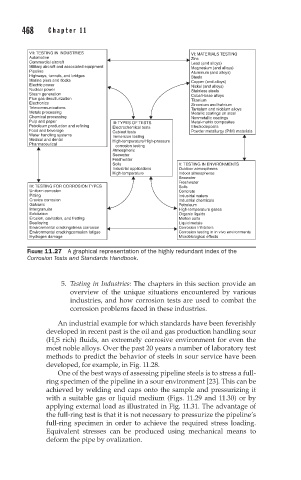Page 501 - Corrosion Engineering Principles and Practice
P. 501
468 C h a p t e r 1 1 M a t e r i a l s S e l e c t i o n , Te s t i n g , a n d D e s i g n C o n s i d e r a t i o n s 469
VII: TESTING IN INDUSTRIES VI: MATERIALS TESTING
Automotive Zinc
Commercial aircraft Lead (and alloys)
Military aircraft and associated equipment Magnesium (and alloys)
Pipeline Aluminum (and alloys)
Highways, tunnels, and bridges Steels
Marine piers and docks Copper (and alloys)
Electric power Nickel (and alloys)
Nuclear power Stainless steels
Steam generation Cobalt-base alloys
Flue gas desulfurization Titanium
Electronics Zirconium and hafnium
Telecommunications Tantalum and niobium alloys
Metals processing Metallic coatings on steel
Chemical processing Nonmetallic coatings
Pulp and paper III: TYPES OF TESTS Metal-matrix composites
Petroleum production and refining Electrochemical tests Electrodeposits
Food and beverage Cabinet tests Powder metallurgy (P/M) materials
Water handling systems Immersion testing
Medical and dental High-temperature/High-pressure
Pharmaceutical corrosion testing
Atmospheric
Seawater
Freshwater
Soils V: TESTING IN ENVIRONMENTS
Industrial applications Outdoor atmospheres
High-temperature Indoor atmospheres
Seawater
Freshwater
IV: TESTING FOR CORROSION TYPES Soils
Uniform corrosion Concrete
Pitting Industrial waters
Crevice corrosion Industrial chemicals
Galvanic Petroleum
Intergranular High-temperature gases
Exfoliation Organic liquids
Erosion, cavitation, and fretting Molten salts
Dealloying Liquid metals
Environmental crackingstress corrosion Corrosion Inhibitors
Environmental crackingcorrosion fatigue Corrosion testing in in vivo environments
Hydrogen damage Microbiological effects
FIGURE 11.27 A graphical representation of the highly redundant index of the
Corrosion Tests and Standards Handbook.
5. Testing in Industries: The chapters in this section provide an
overview of the unique situations encountered by various
industries, and how corrosion tests are used to combat the
corrosion problems faced in these industries.
An industrial example for which standards have been feverishly
developed in recent past is the oil and gas production handling sour
(H S rich) fluids, an extremely corrosive environment for even the
2
most noble alloys. Over the past 20 years a number of laboratory test
methods to predict the behavior of steels in sour service have been
developed, for example, in Fig. 11.28.
One of the best ways of assessing pipeline steels is to stress a full-
ring specimen of the pipeline in a sour environment [23]. This can be
achieved by welding end caps onto the sample and pressurizing it
with a suitable gas or liquid medium (Figs. 11.29 and 11.30) or by
applying external load as illustrated in Fig. 11.31. The advantage of
the full-ring test is that it is not necessary to pressurize the pipeline’s
full-ring specimen in order to achieve the required stress loading.
Equivalent stresses can be produced using mechanical means to
deform the pipe by ovalization.

